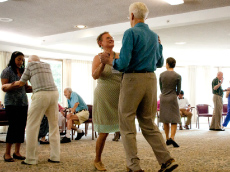It takes 20 to tango
 |
For 15 minutes one Tuesday afternoon, the people begin filing in, one by one, to the dining hall at Emory’s Wesley Woods Towers, a residential facility for seniors. The crowd ranges in age from 60 to 92.
Some chat with friends while others limber up with light stretching. Some walk unaided. Others have canes. But no matter, every face holds a smile because for the next 90 minutes, they know they will be dancing.
As a spicy Latin drum and guitar beat begins to play, they move onto the converted dining room dance floor, the tables and chairs temporarily pushed to the sides. They are here not only for the socializing but also as participants in a study funded by the Department of Veterans Affairs. Researchers want to see if an Argentine tango-based dance program can improve balance, mobility, and quality of life in those who have problems with low vision and have long passed their senior prom.
Barney Schoenberg, 92, pauses in leading his volunteer partner through the steps. “I’ve got bad knees, and I can hardly see,” says Schoenberg, who has strengthened his weak gait into a powerful walk since he’s enrolled in the study.
Today everyone seems to be having a good time. Ed Sporleder, 77, says, “I have not regretted it. It keeps me from getting bored by giving me an activity three times a week, and it teaches me kinematics lessons I can practice between classes.” Like Schoenberg, he has reaped the benefits of better balance, improved mobility, and watching his peers improve.
Madeleine Hackney, an Emory researcher at the Atlanta VA Medical Center and leader of this study, finds that tango is an ideal dance to build stability and endurance. “Tango is much like walking, with more calculated, precise, and intentional steps,” says Hackney. “It may help frail, older people with sensory and motor impairments in terms of balance, gait, and coordination. Tango also incorporates the healthy and safe practice of motor skills that may be impaired by low vision and other health challenges, for example, Parkinson’s disease.” Finally, tango has simpler basic steps and less restricted movement patterns than dances like the waltz and foxtrot, Hackney says.
During the activity, she pairs participants with more stable volunteers to increase stability and ensure the safety of all participants.
Schoenberg has had such a good time as a participant that he successfully recruited his wife, Jean, to join the program and meet new people.
Sporleder has enjoyed seeing some people who were barely shuffling when they joined the study now walking with coordinated, large steps. Through the dancing, friendships have formed among participants and volunteers alike, who have also found encouragement in each others’ progress.
Using a before-and-after comparison of this group who are participating in 20 classes over 11 consecutive weeks, Hackney hopes to show improvement on standardized assessments of walking and balance. Just a few weeks into the study, she already was seeing potential for improvement. An added bonus: the participants are having a great time. –David Knecthle


